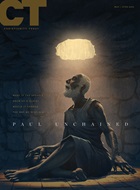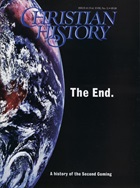The days will come in which vines shall grow," imagined Papias of Hierapolis, "each having ten thousand branches, and in each branch ten thousand twigs, and in each true twig ten thousand shoots, and in each one of the shoots ten thousand clusters, and on every one of the clusters ten thousand grapes, and every grape when pressed will give two hundred gallons of wine. And when any of the saints shall lay hold of a cluster, another shall cry out, 'I am a better cluster, take me; bless the Lord through me.'" Papias (c.60-120) was perhaps the first post-biblical author to describe the thousand-year visible Kingdom of Christ—the Millennium.
The early Gnostic heretic Cerinthus (c.100) elaborated on the physical pleasures of the Millennium—including "nuptial" pleasures—to a degree that scandalized the orthodox.
Some early orthodox and heretical Christians found the tangible, sensual expectations of the Millennium irresistible. But as Christians gained more experience with these expectations, they found sufficient reason to be wary.
The first premillennialist
As years turned into decades, and decades into centuries, it became clear that, in spite of the hopes of some, the Millennium hadn't started with Jesus' resurrection. Although some modern scholars speculate this might have caused dismay, there is no evidence—either in internal exhortations or in answers to external critics—that it bothered anyone.
Christians routinely prayed that the end of the world be postponed. It appears that the delay was simply not an issue. Those who expected the Millennium were confident that it would come. The question was simply when.
As the years wore on, those who thought about the Millennium began to rethink the event that would initiate it. If the Resurrection had not started the Millennium, perhaps the Second Coming would.
Justin Martyr (c.100-c.165) shared Papias's millennial expectation. In his Dialogue with Trypho, Justin affirmed his expectation that the faithful departed would rise from the dead and reign with Christ for a thousand years in a rebuilt Jerusalem. Still, he differed from Papias in two interesting ways.
First, Justin said openly that not all Christians shared his expectation: "I and many others are of this opinion, and believe that such will take place … but, on the other hand, many who belong to the pure and pious faith, and are true Christians, think otherwise." Such tolerance was not given for other doctrines, such as the resurrection of the dead. "Some who are called Christians … say there is no resurrection of the dead, and that their souls, when they die, are taken to heaven; do not imagine that they are Christians" Second, Justin linked the beginning of the Millennium he expected not to Christ's resurrection, as Papias had done, but to Christ's "second advent." He believed faithful Christians would rise from the dead to live with Christ in the new Jerusalem. After the Millennium had been completed, the rest of humanity would rise from the dead; then all would receive the Last Judgment. This seems to be the first post-scriptural writing that placed the Millennium after the Second Coming, thus clearly placing the present age before the Millennium. Justin appears to have been the first premillennialist.
Subsequent writers followed his lead. Irenaeus of Lyons (c. 130-c. 200) is best known for his vigorous defense of Christianity against the Gnostics on such points as the bodily resurrection of the dead. In his book Against all Heresies, Irenaeus followed his teacher Papias, maintaining that when the faithful departed are raised, they will reign with Christ for a thousand years of bliss. Jerusalem would be rebuilt, famine would be unknown, and animals would live in harmony with each other and with man. However, like Justin and unlike Papias, Irenaeus expected this to happen after the coming of the Antichrist and the second coming of Christ.
Calming the enthusiasts
Justin and Irenaeus spoke of the Millennium as a far-off event they hoped for someday. Its only importance to Christian living was as a reminder of the hope that should guide a Christian's life. But late in the 100s, some Christians began to see signs that the Millennium was imminent. The most worrisome of these were the Montanists.
Probably in 172, Montanus began to proclaim that Jerusalem would soon descend near Phrygia (west-central Asia Minor). Montanus and his female associates, Prisca and Maximilla, claimed the Millennium had begun and God had given them authority over the Christian church. To reject their pronouncements, they said, was to blaspheme against the Holy Spirit: Luke 12's "unforgivable sin." Montanus was eventually condemned by the church, though not for his eschatology.
In the early 200s, Hippolytus of Rome predicted that Christ would establish the Millennium in 496. He was one of the few early writers to predict the date of the Second Coming, but not for reasons we'd expect. Better known for his Apostolic Tradition, which contains one of the earliest surviving texts of a prayer to consecrate the bread and cup during Communion, Hippolytus worked out this date in his ground breaking study of the book of Daniel—the earliest surviving Christian commentary on a single book of the Bible.
The question of the Second Coming was a lively one at the time. A few chapters before his date prediction, Hippolytus told of a foolish Syrian church leader who had led his people into the desert to await the Second Coming. Another leader, this time in Pontus (northern Asia Minor), had predicted that Christ would come again in a year's time. His people trusted him as they trusted Scripture itself, and when the year ended without the Second Coming, they were devastated. Many despaired of Scripture and of their religion: "The virgins got married; the men withdrew to their farms; and those who had recklessly sold all their possessions were eventually to be found begging."
Millennial expectations were gaining a bad name, so Hippolytus wanted to dampen expectations. He first worked out the date of Christ's birth: 5,500 years after the world was created. He then reckoned that the Millennium would begin 6,000 years after the creation of the world, so that the world would end after 7,000 years—a commonly-held view in those days. Clearly, then, Christ would return 500 years after his birth—and nearly three centuries after Hippolytus's book. Placing Christ's return so far in the future probably helped Hippolytus defuse the expectations of Christians who expected to see the Millennium soon.
Another attempt to dampen millennial expectations was made by the great thinker of the third-century church, Origen (c. 185-c. 254). Origen took delight in allegory and symbolism and felt no need to interpret Daniel or Revelation literally. Yes, the "best" Christians will be princes and rulers, but they will both rule over "the souls of lower condition" and also teach them about higher things, so that they can be fashioned into a "living stone" that can take its place in the spiritual Jerusalem to come.
Origen's allegorical approach also focused on actions performed by faithful souls, rather than on an unfolding millennial chronology. In this way, Origen could contrast the pagan submission to Fate against the Christian sense that one's choices made a difference. An increasing number of Christian thinkers would come to prefer this approach.
The "great Captain" arrives
When the Great Persecution broke upon the church in 303, there was speculation that the dreaded tribulation may have arrived, with the Emperor Diocletian as the first beast of Revelation 13, and his Caesar Galerius as the second beast.
Then Constantine won the empire in battle in 312 and immediately called a halt to the persecution. He promised to restore the church's property and offered to act as its sponsor and patron. The surviving Christians were ecstatic. "The Angel of the mighty council, the great Captain and Leader of the armies of God … suddenly appeared," wrote Eusebius of Caesarea (c. 260-340) referring to Constantine.
In the face of such joyous circumstances, who needed to hope for a Millennium in the indefinite future? It was easy to conclude the Millennium had indeed arrived, and that Christ's second coming would occur at some date after the Millennium was complete—a postmillennial view.
Dana Netherton is a freelance writer with a Ph.D. in church history from the University of London.
Copyright © 1999 by the author or Christianity Today/Christian History magazine.
Click here for reprint information on Christian History.

Support Our Work
Subscribe to CT for less than $4.25/month





























